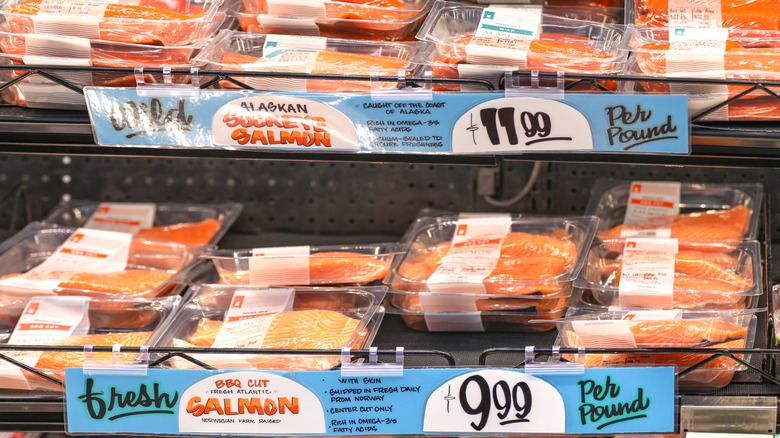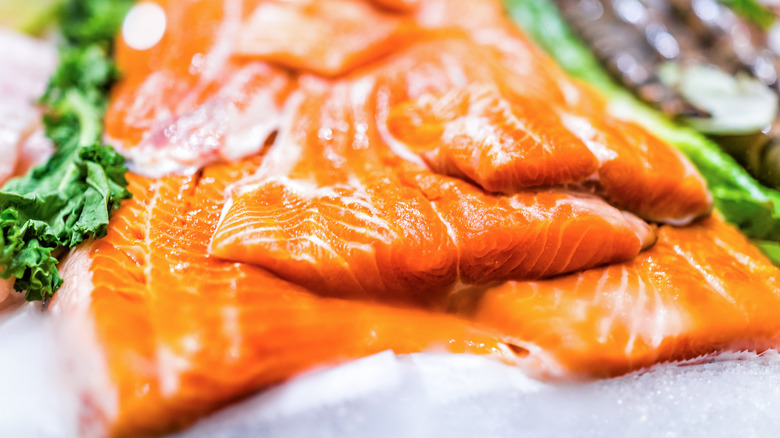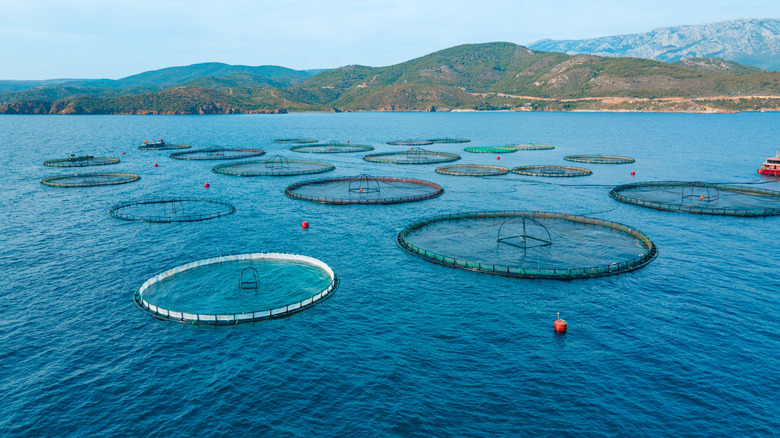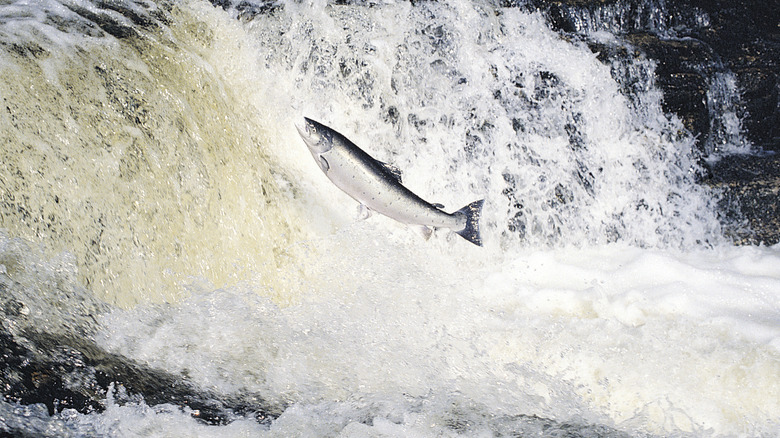Here Are The Biggest Differences Between Wild And Farmed Salmon
Salmon isn't just a delicious protein choice — it's a cornerstone to a healthy diet thanks to all the omega-3s and other nutrients. But there are so many distinctions and differences in labeling that it can be difficult to determine what type of salmon is best to eat. You might have even thought to yourself, "Well, it's all salmon, how different can they be?" The answer is a lot. A lot different. The great debate in choosing wild over farmed salmon comes down to variation in these categories: breed, taste, color, location, and potential contaminants. Knowing what these differences entail and what the buzzwords on packaging actually mean will help you swim, not sink, the next time you're craving some easy salmon burgers you can throw in the air fryer.
A cool aspect of salmon — regardless of the method of upheaval from the ocean — is that they're all diadromous. This is pretty much fancy fish talk for being able to swim in the freshwater they hatch in and the salt water where they live most of their lives. Salmon fall into the anadromous type of diadromous species, which means they swim upstream to the freshwater from whence they came to lay their own eggs. They're able to do this due to their body's ability to maintain the proper internal salt-to-water ratio required for survival. Only a handful of fishes are capable of this! So, they're not only delicious but also biologically ingenious. With that, let's dive into the differences between farmed and wild.
The gray area in farming salmon
The breed of salmon can sometimes indicate if the fish was wild-caught or farmed. There are eight different breeds of the fish, and they are grouped by the oceans in which they're found. There is only one that lives in the Atlantic, aptly named "Atlantic salmon." This label is the first indicator that the salmon was farm-raised. All Atlantic salmon sold in the United States is reared this way. Even if the label credits the fish to somewhere in Scandinavia — "Norwegian Atlantic salmon," for instance. Due to devastating effects rampant overfishing of the ocean has had on the breed and its environment, commercial and recreational salmon fishing is prohibited in America. Atlantic salmon isn't the only type of salmon that can be farmed-raised, but it is the most common and accessible.
Some celebrated chefs have boasted of farm-raised salmon's richer taste from the thick ribbons of fat. They are more noticeable in this type than in their wild counterparts, which can make them seem more appealing. The taste and fat content are simulated, though. Farm-raised salmon are fed a specific diet to give them a higher fat content and richer flavor. And while they might have more omega-3s, they're also higher in saturated fat, which is counterproductive.
The idea that they are injected with dyes after being harvested is a misconception. In actuality, synthetic antioxidants are also used to bolster the appearance of farm-raised salmon via their feed — you could liken this to taking supplemental vitamin D over going outside for us humans. The color of wild salmon comes from its naturally occurring diet. But since farm-raised salmon eat synthetic food, they have to be synthetically colored a pinkish orange because a gray fillet of salmon doesn't look appetizing.
Farm-to-table, but not how you're thinking
Farm-raising salmon comes with any of the same pitfalls as the factory farming of other livestock. As with land animals kept in close quarters, disease can spread through the pens holding the fish due to their proximity to each other. Antibiotics are used to prevent this, which might sound innocuous when isolated. But it's more frightening when you realize that the Food and Drug Administration (FDA) says 80% of antibiotic use in the United States is for industrially farmed animals.
Naturally occurring contaminants referred to as persistent organic pollutants (POPs) are an unfortunate reality for any seafood product due to the contamination of oceans and have been linked to some pretty serious illnesses. According to the Environmental Working Group, POPs like polychlorinated biphenyl (PCB) are more than 16 times higher in farm-raised salmon compared to wild-caught because they are overseen by two separate government entities with different standards. Wild-caught salmon falls under the jurisdiction of the Environmental Protection Agency (EPA) jurisdiction, while farm-raised is covered by the FDA.
One exception to the perils of farm-raised salmon is New Zealand's Ora King. King Salmon, the company responsible for the brand, refers to it as "the wagyu beef of the salmon world." What sets Ora King apart from typical king salmon is the way it's farmed and the fact that this offshoot breed is genetically unique — think "Gattaca," but with salmon. New Zealand King Salmon is a world leader in sustainable fish farming. The company never uses antibiotics, synthetic dyes, or artificial hormones in the feed, and feeding is closely monitored. Plus, Global Seafoods North America says its ocean marine nets have 98 percent water to 2 percent fish. If you're going to go for a farm-raised salmon, Ora King is a high-quality fish that will taste fantastic as a dijon-crusted filet or even as sashimi.
Wild-caught is typically better
Apart from Ora King, an outlier when it comes to fish farming, five natural breeds of salmon are caught from the Pacific Ocean for U.S. consumption: chinook (also known as king), coho, chum, sockeye, and pink. With wild-caught salmon, regardless of breed, you're getting the salmon in its most natural state, most natural color, and cleanest flavor. Wild-caught salmon will look less like Cheetos' orange and range from deep shades of red to a naturally occurring salmon (the color) or a darker coral in pink salmon (hence the name).
Variance in the coveted omega-3 fat content for wild-caught salmon will depend on the water temperature and migration pattern from breed to breed. The colder the water, the higher the fat content needed to maintain its body temperature, and the tastier the fish. The longer the migration pattern, the more fat their bodies store, the more marbled the fat content, and, you guessed it — the tastier the fish. A prime example of this is the coveted Colombia River king salmon, which is lauded for its rich marbling. Their migration spans over 1,200 miles through frigid temperatures. If you're worried about ruining your wild-caught salmon when preparing one of the leaner breeds, try cooking with a little extra fat (butter or oil) so it doesn't stick to the pan.
Despite the otherwise au naturelle life of wild-caught salmon, water pollution can still affect them, though drastically not as much as with farm-raised species. There's also little risk for antibiotic contamination in wild-caught fish (there could be trace amounts from the environment) as they have more room to swim and less disease. So go wild when shopping for salmon. The natural health benefits are higher, the taste is fresher, and the risks for synthetic additives and pollutants are much lower.




